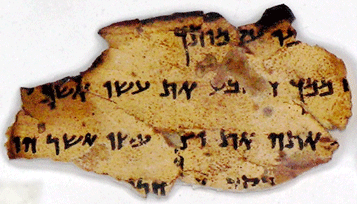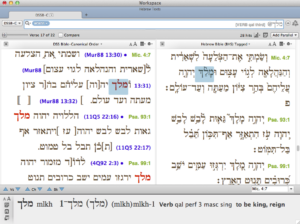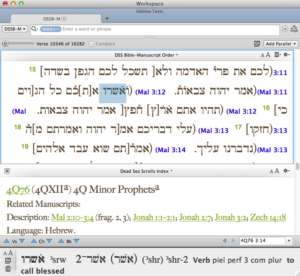Page Navigation
- Announcement
- The Importance of the Biblical Texts
- Martin Abegg and Colleagues
- Endorsement by Emanuel Tov
![]() OakTree Software is pleased to announce the release of the Dead Sea Scrolls Biblical Manuscripts for use with Accordance Bible Software
OakTree Software is pleased to announce the release of the Dead Sea Scrolls Biblical Manuscripts for use with Accordance Bible Software

These important new Accordance modules (DSSB-C and DSSB-M) represent the entire Hebrew and Aramaic corpus of the biblical scrolls found in the Judean Desert between 1947 and today. They include not only Qumran, but also Masada, Nahal Hever, Murabba’at, etc. The transcription and format faithfully follow the text of the official publication series, The Discoveries in the Judaean Desert (Oxford, 1955—) and other related publications.
Over three years in preparation, the DSSB-C presents every manuscript in canonical order, so that every witness to each verse can be compared at once and with any other version such as the Masoretic or Samaritan text, or the English translation of the Dead Sea Scrolls Bible. The DSSB-M presents the texts in manuscript order and can be used in parallel with the Qumran Index module. Both modules include complete lexical and morphological analysis, and English glosses, facilitating searches for different forms of words, and for grammatical constructions. They are completely integrated into Accordance and hypertext to the Hebrew and Aramaic lexicons, and to any other available Accordance resources. Advanced search and analysis capabilities allow the user to create and customize graphic and textual presentations of the search results.
Canonical order with Hebrew Bible in parallel
(Click for full size image)
![]() The Importance of the Biblical Texts of the Dead Sea Scrolls
The Importance of the Biblical Texts of the Dead Sea Scrolls
by Casey Toews
The answer to the question, How did we get the Bible?, has long fascinated scholars and popular readers alike. And where that question regards the most ancient collection of Scripture, the Hebrew Bible (Old Testament), the fascination is shared equally among both Jewish and Christian interests. The question looms, primarily, as a result of the disappearance of the original biblical documents from the historical record. In the absence of those original manuscripts, scholars are left with the task of reconstructing the earliest shape of the text from later, surviving manuscripts. These manuscripts, transmitted by scribes, at various times over the centuries, from various places, and in various languages are of vital importance. Along with the Hebrew (Masoretic) documents, important collections in Greek (the Septuagint), Samaritan Hebrew (the Samaritan Pentateuch), Aramaic (the Targums), Syriac (the Peshita) and Latin (the Vulgate) have survived, and have provided important clues for scholars in their reconstructions of the Bible. Despite this breadth of witness, attempts at reconstruction have been significantly limited since the best available Hebrew manuscript evidence does not appear until the 11th century CE.
This situation was dramatically improved with the twentieth century discovery and publication of biblical manuscripts located in and around the Dead Sea, dating one millennium earlier–approximately third century BCE to first century CE–than the oldest Hebrew (Masoretic) texts previously known. These Dead Sea Scrolls, unearthed from Wadi Murabba’at, Nahal Hever, Masada, Wadi Sdeir, Wadi Seiyal, Nahal Se’elim and of course, and most importantly, from the various caves around Qumran have reshaped approaches to understanding the formation of the Hebrew Bible. Scholars now have witnesses to the shape of the Hebrew Bible from its formative period, and to no surprise, the first fifty years of research since their discovery has left a lasting impact. Ground breaking theories regarding the fluidity of the text in this earliest setting and the relationship of the Hebrew Bible to other language traditions of the period have been established. The next fifty years will no doubt continue to see evidence from the Dead Sea Scrolls transform scholarship’s understanding of how we got the Hebrew Bible.
It is into this robust academic journey of discovery that Accordance provides an exceptional tool for textual study of the biblical texts of the Dead Sea Scrolls. The Dead Sea Scrolls Biblical Manuscripts modules contain transcriptions of all the biblical manuscripts from Qumran, Wadi Murabba’at, Nahal Hever, Masada, Wadi Sdeir, Wadi Seiyal and Nahal Se’elim. The texts may be displayed either in canonical or manuscript order. Each word is grammatically-tagged, enabling research into the distinctiveness of the Dead Sea Scrolls and their variance to the Masoretic traditions. And since Accordance also provides grammatically-tagged databases of the Septuagint, Samaritan Pentateuch, Targums, Peshita and Vulgate, a researcher using the Dead Sea Scrolls Biblical Manuscripts can perform world class, synoptic analysis of the world’s most important collections of ancient, biblical texts. As such, Qumran Biblical Texts provides the world a tool which can contribute to this cutting-edge field of scholarship, a field which continues to feel the impact of the Dead Sea Scrolls in the reconstruction of the Hebrew Bible in its earliest setting.
Manuscript order with Qumran Index in parallel
(Click for full size image)
![]() Martin Abegg and Colleagues
Martin Abegg and Colleagues
Martin G. Abegg, Jr., James E. Bowley, and Edward M. Cook are responsible for preparing the text and morphological analysis for electronic publication. Abegg is The Ben Zion Wacholder Professor of Dead Sea Scroll studies at Trinity Western University in Langley, British Columbia. He earned his Ph.D. from Hebrew Union College in Cincinnati, Ohio and wrote his dissertation on the War Scroll from Qumran Cave 1 under the supervision of Professor Ben Zion Wacholder. His areas of academic expertise are the Dead Sea Scrolls, Syriac Language and Literature, and Hebrew Bible. Abegg is the author of numerous scholarly articles related to scroll research, and has contributed to or co-edited several important works on the Dead Sea Scrolls, including: The Dead Sea Scrolls Concordance, vol. I (with J. Bowley and E. Cook); The Dead Sea Scrolls: A New Translation (with M. Wise and E. Cook); and The Dead Sea Scrolls Bible (with P. Flint and E. Ulrich). Abegg also contributed to the official publication series of the Dead Sea Scrolls. Abegg’s work with electronic databases is extensive, having prepared the QUMRAN, MISH-T, SAMAR-T, and BENSIRA-C/M Accordance modules for the study of ancient Hebrew Language and Literature.
The royalties from this publication are being donated to the Dead Sea Scrolls Foundation to support future research.
![]() Endorsement by Emanuel Tov
Endorsement by Emanuel Tov
“This excellent research and study tool allows the user to search for all the words and grammatical categories in the biblical manuscripts from the Judean Desert, both by biblical book and by manuscript. It allows for analysis of both individual scrolls or groups of scrolls. The details of the professional morphological analysis and English glosses of the Hebrew/Aramaic words are visible at the click of a mouse. With the advantage of having the wording of the official publications at your disposal and with the flexible possibilities of the Accordance program (such as custom-made concordances, graphic distribution charts, and a comparison of the scrolls with any text, such as the Masoretic Text) one cannot wish for a better tool for the study and research of the Dead Sea Scrolls, both of the biblical and non-biblical texts.”
Prof. Emanuel Tov
Editor-in-Chief, International Dead Sea Scrolls Publication Project
Dead Sea Scrolls Biblical Manuscripts
Reg Price $149
Buy Now
Check all the Dead Sea Scrolls Resources here.
Note: Prices are subject to change at any time. If there is a difference between the prices listed above and the prices listed on the product page, the prices on the product page should be considered correct.



